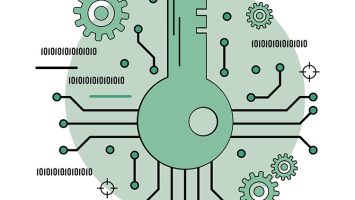As digital advancements continue to shape our world, the importance of cybersecurity has become more paramount than ever. With hackers constantly finding new ways to breach security systems, it begs the question: what tools do cybersecurity professionals rely on to safeguard our data? From sophisticated software programs that sniff out malicious code to cutting-edge encryption techniques that fortify sensitive information, this article will delve into the arsenal of resources used by these modern-day guardians of cyberspace. Prepare to take a deep dive into the world of cybersecurity and discover the technology that keeps us safe in an increasingly interconnected world.
Contents
The importance of cybersecurity in today’s world
With the ever-increasing dependence on technology and the widespread use of the internet, cybersecurity has become an essential aspect of our daily lives. From personal information to financial data, almost everything is stored digitally and vulnerable to cyber threats. The importance of cybersecurity in today’s world cannot be emphasized enough.
In recent years, we have witnessed numerous high-profile cyber attacks targeting governments, businesses, and individuals alike. These attacks not only result in significant financial losses but also compromise sensitive information that can be used for various malicious purposes. As technology continues to advance at a rapid pace, so does the sophistication of cyber threats. This makes it crucial for individuals and organizations to maintain robust cybersecurity measures to protect themselves from these evolving dangers.
Furthermore, with the increasing popularity of cloud computing and remote work arrangements, ensuring strong security protocols has become even more critical. Data breaches can have far-reaching consequences that go beyond financial losses; they can lead to reputational damage and loss of trust among customers or clients. Given this landscape, cybersecurity professionals play a vital role in safeguarding digital assets through their expertise in threat detection, prevention, and mitigation strategies.
In conclusion, as technology becomes an integral part of our everyday lives and digitization continues to expand across industries, safeguarding against cyber threats has never been more crucial. Investing in robust cybersecurity measures is no longer optional; it is a necessity for individuals and organizations alike if they want to avoid falling victim to potentially devastating cyber-attacks.

Common tools used by cybersecurity professionals
Cybersecurity professionals rely on a variety of tools to protect networks and systems from malicious threats. One commonly used tool is the firewall, which acts as a barrier between an internal network and external networks, monitoring and filtering incoming and outgoing network traffic. Firewalls can be hardware-based or software-based, but both function to prevent unauthorized access and potential breaches. While firewalls provide an essential first line of defense, they are just one piece of the cybersecurity puzzle.
Another crucial tool in a cybersecurity professional’s arsenal is the intrusion detection system (IDS). This software monitors network traffic for any suspicious or unauthorized activity. It analyzes packets of data for known attack signatures or unusual behavior that could indicate a cyber attack in progress. Coupled with an intrusion prevention system (IPS), which actively blocks malicious traffic, IDS provides real-time threat identification and response capabilities. By continuously monitoring network activity, IDS helps safeguard against increasingly sophisticated cyber threats that can bypass traditional security measures.
In addition to firewalls and IDS/IPS systems, cryptography plays an essential role in maintaining data confidentiality and integrity. Cybersecurity professionals utilize encryption tools like Virtual Private Networks (VPNs) to secure sensitive information when it is transmitted over public networks. Encryption scrambles data into unreadable code, ensuring that only authorized individuals possess the cryptographic keys needed to decrypt it. These encryption techniques safeguard against eavesdropping attacks on sensitive communications such as passwords or financial transactions.
Network monitoring and analysis tools
Network monitoring and analysis tools are an indispensable part of a cybersecurity professional’s toolkit. These tools help monitor network traffic, detect anomalies, and identify potential security threats. One popular tool in this category is Wireshark, widely used for analyzing network packets in real-time. Wireshark allows professionals to closely examine the packets flowing through their network, providing valuable insights into the source and destination of traffic, as well as any suspicious activity.
Another notable tool is Nagios, known for its comprehensive monitoring capabilities across various aspects of a network infrastructure. With Nagios, cybersecurity professionals can monitor everything from server performance to application availability and even environmental conditions such as temperature and humidity levels. This holistic approach to network monitoring ensures that no stone is left unturned when it comes to detecting potential vulnerabilities or unauthorized access attempts.
In recent years, there has been a rise in cloud-based network monitoring tools such as SolarWinds Network Performance Monitor (NPM). These cloud-based solutions offer scalability and flexibility while providing deep visibility into an organization’s entire IT infrastructure. Furthermore, they often come equipped with features like automated alerting systems and advanced reporting capabilities that enable proactive threat detection and prompt incident response.
By incorporating these robust network monitoring and analysis tools into their arsenal, cybersecurity professionals can ensure the safety of their organization’s networks by proactively identifying security incidents before they escalate. These tools not only provide real-time visibility but also enable retrospective analysis for identifying patterns or trends that may have gone unnoticed initially.

Vulnerability management and scanning tools
Vulnerability management is a critical component of any effective cybersecurity strategy. In today’s constantly evolving threat landscape, it is important for organizations to stay ahead by proactively identifying and mitigating potential vulnerabilities in their systems and networks. This is where vulnerability scanning tools come into play.
These tools automate the process of identifying vulnerabilities by actively scanning an organization’s IT infrastructure, applications, and network devices. They help cybersecurity professionals discover weaknesses, misconfigurations, and outdated software that could be exploited by attackers. By providing detailed reports outlining the vulnerabilities found, these tools enable organizations to prioritize remediation efforts effectively.
One key aspect to consider when choosing a vulnerability scanning tool is its ability to integrate with existing security systems such as intrusion detection and prevention systems (IDPS) or security information and event management (SIEM) solutions. Seamless integration allows for real-time monitoring of vulnerabilities, timely alerts for critical issues, and efficient collaboration between different security teams.
Moreover, advanced vulnerability management solutions can not only scan traditional on-premises infrastructure but also cloud environments. With the increasing adoption of cloud services, including Infrastructure as a Service (IaaS), Platform as a Service (PaaS), and Software as a Service (SaaS), it is vital to have comprehensive visibility across all environments.
In conclusion, vulnerability management tools play an indispensable role in safeguarding organizations against cyber threats by facilitating proactive identification and remediation of vulnerabilities.
Intrusion detection and prevention systems
Intrusion detection and prevention systems (IDPS) have become crucial tools in the arsenal of cybersecurity professionals. These robust systems provide an essential layer of defense against external threats, constantly scanning networks for any signs of unauthorized access or suspicious activity. With the ever-increasing sophistication of cyber attacks, IDPSs are continuously evolving to keep up with new threats and vulnerabilities.
One fresh perspective on IDPSs is their ability to not only detect but also prevent intrusions in real-time. Unlike traditional firewalls that only monitor incoming and outgoing traffic, IDPSs actively analyze network activity to identify potential security breaches. By monitoring network packets and analyzing trends and patterns, these systems can pinpoint potential threats before they even reach critical assets.
Moreover, IDPSs have made significant advancements in behavioral analysis algorithms, allowing them to identify abnormal user behavior within a network. This approach goes beyond signature-based detection methods by closely monitoring user actions and identifying any deviations from normal patterns. By doing so, they can efficiently detect insider threats or compromised credentials that may otherwise go unnoticed.
Intrusion detection and prevention systems are not only valuable for safeguarding networks but also for providing valuable insights into ongoing cyber attacks. Cybersecurity professionals use these systems to conduct detailed forensic analysis after an intrusion occurs, which helps in understanding attack vectors utilized by adversaries. By studying attack patterns and techniques employed during previous incidents, organizations can enhance their defense mechanisms and stay one step ahead of threat actors.

Endpoint security solutions
Endpoint security solutions are a critical and rapidly evolving aspect of cybersecurity. As more organizations shift towards remote work, the endpoints used by employees become highly vulnerable to attacks. Traditional antivirus software is no longer sufficient to protect against increasingly sophisticated threats. Endpoint security solutions have emerged as key tools in defending these vulnerable devices.
One of the most prominent trends in endpoint security is the integration of machine learning and artificial intelligence (AI). Leveraging these technologies allows for real-time threat detection and response, enabling faster action before significant damage occurs. Moreover, AI-powered algorithms can continuously learn from patterns and anomalies across networks, building a strong defense system that adapts to ever-changing cyber threats.
Another exciting development in endpoint security is the concept of zero trust architecture. Unlike traditional network security approaches that rely on perimeter-based defenses, zero trust assumes that every end-user device may be compromised or out-of-compliance at any time. This approach requires strict user authentication, access controls based on role-based policies, continuous monitoring of device behavior, and encryption throughout data transmission. By adopting a zero trust model, organizations significantly reduce their vulnerability surface area and minimize the potential impact of a breach.
In conclusion, adopting robust endpoint security solutions has become crucial in today’s digital landscape where devices are constantly exposed to various cyber threats. The incorporation of AI-driven technologies enables proactive protection against emerging risks while empowering cybersecurity professionals with better insights into potential vulnerabilities.
Conclusion: The evolving landscape of cybersecurity
As the digital landscape continues to evolve at a rapid pace, cybersecurity professionals are facing new challenges and opportunities. With emerging technologies such as artificial intelligence, cloud computing, and Internet of Things (IoT), the threat landscape is expanding exponentially. A recent study by Cybersecurity Ventures predicts that cybercrime damages will cost the world $10.5 trillion annually by 2025.
To keep up with this evolving landscape, it is critical for cybersecurity professionals to stay updated on the latest tools and techniques. Traditional security measures like firewalls and antivirus software are no longer sufficient in protecting against advanced threats. Professionals now rely on more sophisticated tools such as intrusion detection systems (IDS), security information and event management (SIEM) platforms, and vulnerability assessment scanners.
Moreover, collaboration is key in combating ever-evolving cyber threats. The industry has recognized that sharing threat intelligence is crucial for staying one step ahead of cybercriminals. Organizations now participate in information-sharing programs where real-time data about attacks and vulnerabilities are exchanged among trusted partners or government agencies.
In conclusion, cybersecurity professionals must adapt to the fast-paced nature of the evolving threat landscape by utilizing advanced tools and collaborating with others in the industry. With continuous learning and openness to new approaches, these professionals can effectively protect organizations from cyber threats amidst an increasingly complex digital world.




Comments (No)